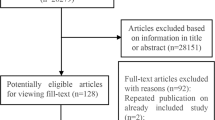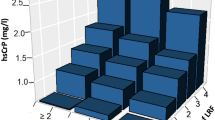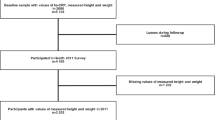Abstract
OBJECTIVE:
To clarify the role of body mass index (BMI, kg/m2) adjustment in predictive models for cardiovascular events that add high-sensitivity C-reactive protein (hs-CRP) to the 10-y Framingham Coronary Heart Disease Risk Score (FCRS).
DESIGN:
A cross-sectional study in a group of apparently healthy individuals.
SUBJECTS:
In all, 1512 apparently healthy individuals (955 men and 557 women) at a respective age of 49.7±10.6 and 50.6±9.6 y.
RESULTS:
The Pearson correlation between hs-CRP and the calculated 10-y FCRS was lower when adjusted for BMI. This reduction was especially noted in women where it dropped from 0.247 to 0.09. The dominant role of hs-CRP concentrations was also noted in a linear regression model, again, especially noted in women (drop of the standardized coefficient from 0.517 for BMI to 0.08 for the FCRS).
CONCLUSIONS:
The correlation between hs-CRP and the 10-y FCRS is partly related to the presence of obesity. We raise the possibility that the addition of BMI to the predictive model of FCRS might attenuate the cost-effectiveness of CRP measurements for this specific risk assessment.
This is a preview of subscription content, access via your institution
Access options
Subscribe to this journal
Receive 12 print issues and online access
$259.00 per year
only $21.58 per issue
Buy this article
- Purchase on Springer Link
- Instant access to full article PDF
Prices may be subject to local taxes which are calculated during checkout

Similar content being viewed by others
References
Bray GA . Risks of obesity. Endocrinol Metab Clin N Am 2003; 32: 787–804 viii.
Anderson KM, Odell PM, Wilson PW, Kannel WB . Cardiovascular disease risk profiles. Am Heart J 1991; 121: 293–298.
Wilson PW, D’Agostino RB, Levy D, Belanger AM, Silbershatz H, Kannel WB . Prediction of coronary heart disease using risk factor categories. Circulation 1998; 97: 1837–1847.
Albert MA, Glynn RJ, Ridker PM . Plasma concentration of C-reactive protein and the calculated Framingham Coronary Heart Disease Risk Score. Circulation 2003; 108: 161–165.
Labarrere CA, Lee JB, Nelson DR, Al Hassani M, Miller SJ, Pitts DE . C-reactive protein, arterial endothelial activation, and development of transplant coronary artery disease: a prospective study. Lancet 2002; 360: 1462–1467.
Pasceri V, Willerson JT, Yeh ETH . Direct proinflammatory effect of C-reactive protein on human endothelial cells. Circulation 2000; 102: 2165–2171.
Torzewski M, Rist C, Mortensen RF, Zwaka TP, Bienek M, Waltenberger J, Koenig W, Schmitz G, Hombach V, Torzewski J . C-reactive protein in the arterial intima: role of C-reactive protein receptor-dependent monocyte recruitment in atherogenesis. Arterioscler Thromb Vasc Biol 2000; 20: 2094–2099.
Ballou SP, Lozanski G . Induction of inflammatory cytokine release from cultured human monocytes by C-reactive protein. Cytokine 1992; 4: 361–368.
Venugopal SK, Devaraj S, Jialal I . C-reactive protein decreases prostacyclin release from human aortic endothelial cells. Circulation 2003; 108: 1676–1678.
Kobayashi S, Inoue N, Ohashi Y, Terashima M, Matsui K, Mori T, Fujita H, Awano K, Kobayashi K, Azumi H, Ejiri J, Hirata Ki, Kawashima S, Hayashi Y, Yokozaki H, Itoh H, Yokoyama M . Interaction of oxidative stress and inflammatory response in coronary plaque instability: important role of C-reactive protein. Arterioscler Thromb Vasc Biol 2003; 23: 1398–1404.
Torzewski J, Torzewski M, Bowyer DE, Frohlich M, Koenig W, Waltenberger J, Fitzsimmons C, Hombach V . C-reactive protein frequently colocalizes with the terminal complement complex in the intima of early atherosclerotic lesions of human coronary arteries. Arterioscler Thromb Vasc Biol 1998; 18: 1386–1392.
Paul A, Ko KWS, Li L, Yechoor V, McCrory MA, Szalai AJ, Chan L . C-reactive protein accelerates the progression of atherosclerosis in apolipoprotein E-deficient mice. Circulation 2004; 109: 647–655.
Cohen S, Tolshinsky T, Rogowski O, Shapira I, Lachmi K, Hirsch M, Ben Assayag E, Burke M, Deutch V, Berliner S, Halpern P, Serov J . Real time, control adjusted evaluation of intensity of the inflammatory response. J Inform Technnol Healthcare 2003; 1: 195–207.
Rifai N, Tracy RP, Ridker PM . Clinical efficacy of an automated high-sensitivity C-reactive protein assay. Clin Chem 1999; 45: 2136–2141.
Libby P, Ridker PM, Maseri A . Inflammation and atherosclerosis. Circulation 2002; 105: 1135–1143.
Ridker PM . On evolutionary biology, inflammation, infection, and the causes of atherosclerosis. Circulation 2002; 105: 2–4.
Sesso HD, Buring JE, Rifai N, Blake GJ, Gaziano JM, Ridker PM . C-reactive protein and the risk of developing hypertension. JAMA 2003; 290: 2945–2951.
Frohlich M, Sund M, Lowel H, Imhof A, Hoffmeister A, Koenig W . Independent association of various smoking characteristics with markers of systemic inflammation in men. Results from a representative sample of the general population (MONICA Augsburg Survey 1994/95). Eur Heart J 2003; 24: 1365–1372.
Ridker PM, Buring JE, Cook NR, Rifai N . C-reactive protein, the metabolic syndrome, and risk of incident cardiovascular events: an 8-year follow-up of 14 719 initially healthy American women. Circulation 2003; 107: 391–397.
Hackam DG, Anand SS . Emerging risk factors for atherosclerotic vascular disease: a critical review of the evidence. JAMA 2003; 290: 932–940.
Lemieux I, Pascot A, Prud’homme D, Almeras N, Bogaty P, Bergeron J, Despres JP . Elevated C-reactive protein: another component of the atherothrombotic profile of abdominal obesity. Arterioscler Throm Vasc Biol 2001; 21: 961–967.
Pannacciulli N, Cantatore FP, Minenna A, Bellacicco M, Giorgino R, De Pergola G . C-reactive protein is independently associated with total body fat, central fat, and insulin resistance in adult women. Int J Obes Relat Metab Disord 2001; 25: 1416–1420.
Festa A, D’Agostino Jr R, Williams K, Karter AJ, Mayer-Davis EJ, Tracy RP, Haffner SM . The relation of body fat mass and distribution to markers of chronic inflammation. Int J Obes Relat Metab Disord 2001; 25: 1407–1415.
Thorand B, Lowel H, Schneider A, Kolb H, Meisinger C, Frohlich M, Koenig W . C-reactive protein as a predictor for incident diabetes mellitus among middle-aged men: results from the MONICA Augsburg cohort study, 1984–1998. Arch Intern Med 2003; 163: 93–99.
van der Meer IM, de Maat MP, Kiliaan AJ, van der Kuip DA, Hofman A, Witteman JC . The value of C-reactive protein in cardiovascular risk prediction: the Rotterdam Study. Arch Intern Med 2003; 163: 1323–1328.
Ridker PM, Rifai N, Rose L, Burning JE, Cook NR . Comparison of C-reactive protein and low-density lipoprotein cholesterol levels in the prediction of first cardiovascular events. N Engl J Med 2002; 347: 1557–1565.
Koenig W, Lowel H, Baumert J, Meisinger C . C-reactive protein modulates risk prediction based on the Framingham Score: implications for future risk assessment: results from a large cohort study in Southern Germany. Circulation 2004; 109: 1349–1353.
Williams MJ, Williams SM, Milne BJ, Hancox RJ, Poulton R . Association between C-reactive protein, metabolic cardiovascular risk factors, obesity and oral contraceptive use in young adults. Int J Obes Relat Metab Disord 2004; 28: 998–1003.
Author information
Authors and Affiliations
Corresponding author
Rights and permissions
About this article
Cite this article
Rogowski, O., Shapira, I., Toker, S. et al. Obesity-related correlation between C-reactive protein and the calculated 10-y Framingham Coronary Heart Disease Risk Score. Int J Obes 29, 772–777 (2005). https://doi.org/10.1038/sj.ijo.0802939
Received:
Revised:
Accepted:
Published:
Issue Date:
DOI: https://doi.org/10.1038/sj.ijo.0802939



